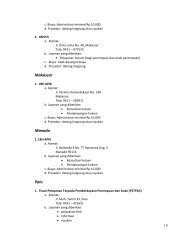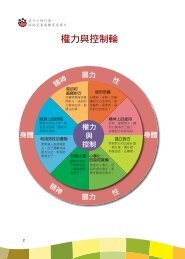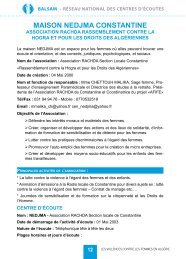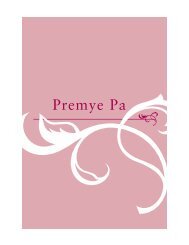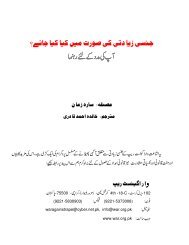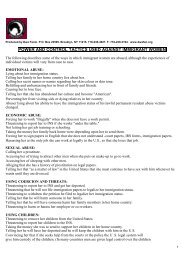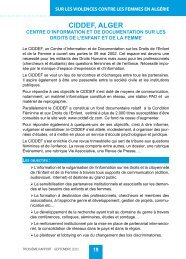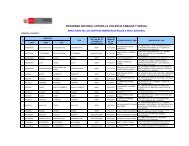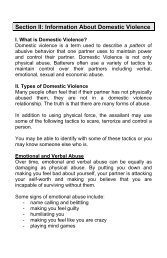Domestic Violence Counseling Manual - Hot Peach Pages
Domestic Violence Counseling Manual - Hot Peach Pages
Domestic Violence Counseling Manual - Hot Peach Pages
Create successful ePaper yourself
Turn your PDF publications into a flip-book with our unique Google optimized e-Paper software.
• Verbally abusive, threatening, or degrading<br />
• Comes from an abusive home, where he saw his father beat his mother<br />
Abusive men may also have problems with communication or may find it natural to express themselves<br />
through violence because they experienced their parents “communicating” in this way (note: this<br />
upbringing still does not excuse the violence, see myth #4). When combined with poor angermanagement<br />
skills, this leads to violence as the vehicle of expression. Anger generally follows a pattern<br />
that starts with self-need/ greed and leads to resentment that this need or greed is not fulfilled:<br />
1. I’m not getting what I want<br />
2. It must be someone else’s fault<br />
3. Someone else is wrong or bad for standing in my way<br />
4. If I remove that obstacle then I’ll get what I want<br />
Resulting violence can release this anger and tension replacing it with the feelings of dominance and<br />
power that come from the satisfaction of getting their own way.<br />
THE PSYCHOLOGY OF THE ENVIRONMENT<br />
There are many external factors that legitimate and facilitate the abuse of women. Again, as with<br />
childhood upbringing, this is not to excuse the violence, or indicate that these are the only reasons, but<br />
only to show the relevant external pressures. Violent actions are always the choice and responsibility of<br />
the individual. External factors fall into six main categories:<br />
1. Media/Entertainment: films and television programs provide male role models who use physical<br />
strength or weapons to solve problems or achieve goals. The media presents violence as exciting.<br />
Overwhelmingly the victims of such violence are women, especially in pornographic films.<br />
2. Societal/Cultural: the long-held concept of the ideal man has been the strong, silent type who<br />
fights his way to the top. Men are expected to be strong, aggressive, and in control, so boys learn<br />
at an early age to use force if necessary to gain and maintain control.<br />
3. Historical/Religious: violence against women is also deeply rooted in our social institutions.<br />
Women have long been regarded as inferior to men; indeed for centuries they were considered the<br />
property of their husbands. Some religions continue to assert these beliefs today, though many<br />
deeply religious people have rejected such teachings.<br />
4. Physical/Genetic: Men are genetically predisposed to be bigger and more muscular than women.<br />
Thus it is often easy for a man to force his wishes on a woman without fear of being physically<br />
injured himself.<br />
5. Economic/Financial: men are traditionally better-educated and better paid than women. It is easy<br />
to dominate someone who is financially dependent and incapable of being self-sufficient.<br />
12-56



